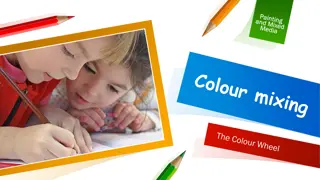Largest Red-Blue Separating Rectangles Study
This study explores the problem of finding the largest area axis-aligned B-empty rectangle containing n red points and m blue points. The research discusses various extensions to the original problem, such as the Blue Rectangles problem and the Outliers Problem, aiming to achieve efficient solutions with time complexities outlined. The motivation behind the research includes applications in tumor separation in radiological images, where red points represent tumor cells and blue points represent healthy cells and tissue. Related work on finding maximal empty rectangles and largest empty rectangles among point sets is also discussed.
Download Presentation

Please find below an Image/Link to download the presentation.
The content on the website is provided AS IS for your information and personal use only. It may not be sold, licensed, or shared on other websites without obtaining consent from the author.If you encounter any issues during the download, it is possible that the publisher has removed the file from their server.
You are allowed to download the files provided on this website for personal or commercial use, subject to the condition that they are used lawfully. All files are the property of their respective owners.
The content on the website is provided AS IS for your information and personal use only. It may not be sold, licensed, or shared on other websites without obtaining consent from the author.
E N D
Presentation Transcript
Largest Red-Blue Separating Rectangles Bogdan Armaselu, Ovidiu Daescu, Chenglin Fan and Benjamin Raichel University of Texas at Dallas
Largest Red-Blue Separating Rectangle Original problem Given: n red points R m blue points B Goal: find largest area axis-aligned B-empty rectangle that contains R (called largest red-blue separating rectangle)
Our contributions We consider extensions of the original problem Blue Rectangles problem Given n red points R and m AA (possibly intersecting) rectangles B Goal is to find largest area rectangle containing all red points and not intersecting any AA rectangle O(m log m + n) time
Our contributions Outliers Problem Given n red points R and m blue points B and an integer k Goal is to find the largest area rectangle enclosing R and containing <= k blue points ( outliers ) O(poly(k) m log m + n) time
Motivation Tumor separation Want to separate tumor from non- tumor in a given radiological H&E- stained image Red points denote tumor cells, blue points (and rectangles) denote healthy cells and surrounding tissue
Related work Nandy et al (1990) [4] Find all maximal empty rectangles (MER) among axis- aligned non-intersecting rectangles O(n log n + r) time, where r is the number of MERs Nandy et al (1994) [3] Find one largest empty rectangle among arbitrary non- intersecting obstacles (such as sticks and polygons) O(n log2n) time Also show how to find empty rectangle inside polygon
Related Work Sharir et al (2012) [2] Find largest empty rectangle among a point set P that contains only a query point q O(n log4n) time pre-processing O(log4n) time query Given q and set B, finds max area rectangle in O(m log m) time Given q and staircase for B, finds max area rectangle in O(m (m)) time
Original Problem Find largest B-empty rectangle enclosing R The lines defining Smin divide the plane into 9 regions: Smin, E, NE, N, NW, W, SW, S, and SE For each such region r, let Br denote the set of blue points located in r Extend Smin in each direction until it touches a blue point in each of E, N, W and S Denote by Smax the resulting rectangle NW N NE Smin E W SW S SE
Original Problem Definition. For p, q NE, pdominatesq if x(p) > x(q), y(p) > y(q) The definition can be applied to other quadrants by swapping inequalities A rectangle enclosing R is BNE -empty if its NE corner does not dominate any points from BNE The staircase ST(NE) of BNE: the NE boundary of region not dominating any blue point in BNE The largest red-blue separating rectangle is the largest rectangle containing Smin and not containing any point of any of the four staircases
Original Staircase The original problem reduces to the Staircase Problem, stated as follows. Given AA rectangles Smin, Smax, with Smin contained in Smax, and a staircase for each quadrant defined by Smin Goal is to find the largest area rectangle S* containing Smin and not containing any point of any staircase. We solve Staircase Problem in O(t) time, where t is the complexity of the staircase Removed (t) factor Since t = O(m) and computing ST() takes O(m log m) time, we solve Original Problem in O(m log m + n) time
Blue Rectangle Problem Want largest rectangle enclosing R while avoiding AA rectangles in B Blue Rectangle Original For side regions, e.g. E, for each rectangle r intersecting E: consider an arbitrary point p E on the left side of r note that a rectangle enclosing Smin intersects r iff it contains p For corner regions, e.g. NE, for each rectangle r crossing NE: consider corner q of r, such that q NE and q does not dominate any point of r note that a rectangle enclosing Smin intersects r iff its NE corner p dominates q Let B be the resulting blue point set Solve Original Problem on R and B
Outliers Problem Want largest rectangle containing R and <= k blue points There are O(k7) ways to partition k into integers kE, , kSE s.t. kE+ + kSE = k For each such partition, we find the largest rectangle that encloses Smin and contains kEpoints from E, kNE from NE, etc. From each side region, e.g. E, we take the (kE+1)-th leftmost point in BE
Outliers Problem Denote by STk(P) the k-th level staircase of P, i.e. chain of points dominating exactly k points in P From each corner region, e.g. NE, we find STk(BNE)
Outliers Problem Lemma 1. For any set P of m points and any integer k, there exists a set Q of O(m) points such that STk(P) = ST(Q). Moreover, STk(P) can be computed in O(m log m) time Proof (sketch). - There are two types of points that can be in Q Points p in P that dominate k points in P Points q not in P but with either the same X coordinate or the same Y coordinate as some point r in P ( breakpoints ) s.t. q dominates k points in P - Thus, the points in ST(Q) dominate exactly k points in P, i.e. ST(Q) = STk(P)
Outliers Problem O(m) points in P dominate k other points in P In a staircase, for each X coordinate of a point, there is at most one breakpoint Hence O(m) breakpoints, so |Q| = O(m) To compute STk(P), sweep a vertical line from Smin to the right Maintain the points in P seen so far, along with # points they dominate, in a balanced BST sorted by Y
Outliers Problem Each point p in P induces an event on STk(P) Based on Y(p) and the contents of BST, can determine the number t of points that p dominates in O(log m) time If t = k, then add p to STk(P)
Outliers Problem Else, if there exist points q, r s.t. r is on ST(P) and q is highest below r to the left of l, then s is a breakpoint, where X(s) = X(p), Y(s) = Y(q) q, r and s can be found in O(log m) time There are O(m) events and we spend O(log m) for each, so O(m log m) in total To solve the k-Outlier Problem for a given quadrant, find the k-th level staircase of the quadrant, then solve the Staircase Problem
Conclusion Theorem 2. Blue Rectangle Problem can be solved in time O(m log m + n) and space O(m + n) Theorem 3. Outliers Problem can be solved in time O(m log m + n) with O(m + n) space for a given partition kE+ + kSE = k Reduction to Staircase Problem This gives O(k7m log m + n) overall
Open problems Faster approach for the outlier case (want to avoid treating all possible partitions of k, thus avoiding the O(k^7) factor) Replace AA rectangles in B with other shapes (circles, polygons, etc) Find largest arbitrary oriented rectangle among different shapes Largest circle among different shapes
References [1] B. Armaselu and O. Daescu. Maximum Area Rectangle Separating Red and Blue Points. CCCG 2016: 244-251 [2] H. Kaplan, S. Mozes, Y. Nussbaum, and M. Sharir. Submatrix maximum queries in monge matrices and monge partial matrices, and their applications. 23rd Annual ACM- SIAM Symposium on Discrete Algorithms: 338-355, 2012. [3] S.C Nandy, A. Sinha, and B.B. Bhattacharya. Location of the largest empty rectangle among arbitrary obstacles. Foundations of Software Technology and Theoretical Computer Science: 159-170, 1994. [4] S. C Nandy, B. B. Bhattacharya and S. Ray. Efficient algorithms for identifying all maximal isothetic empty rectangles in VLSI layout design. FSTTCS 1990: 255-269























